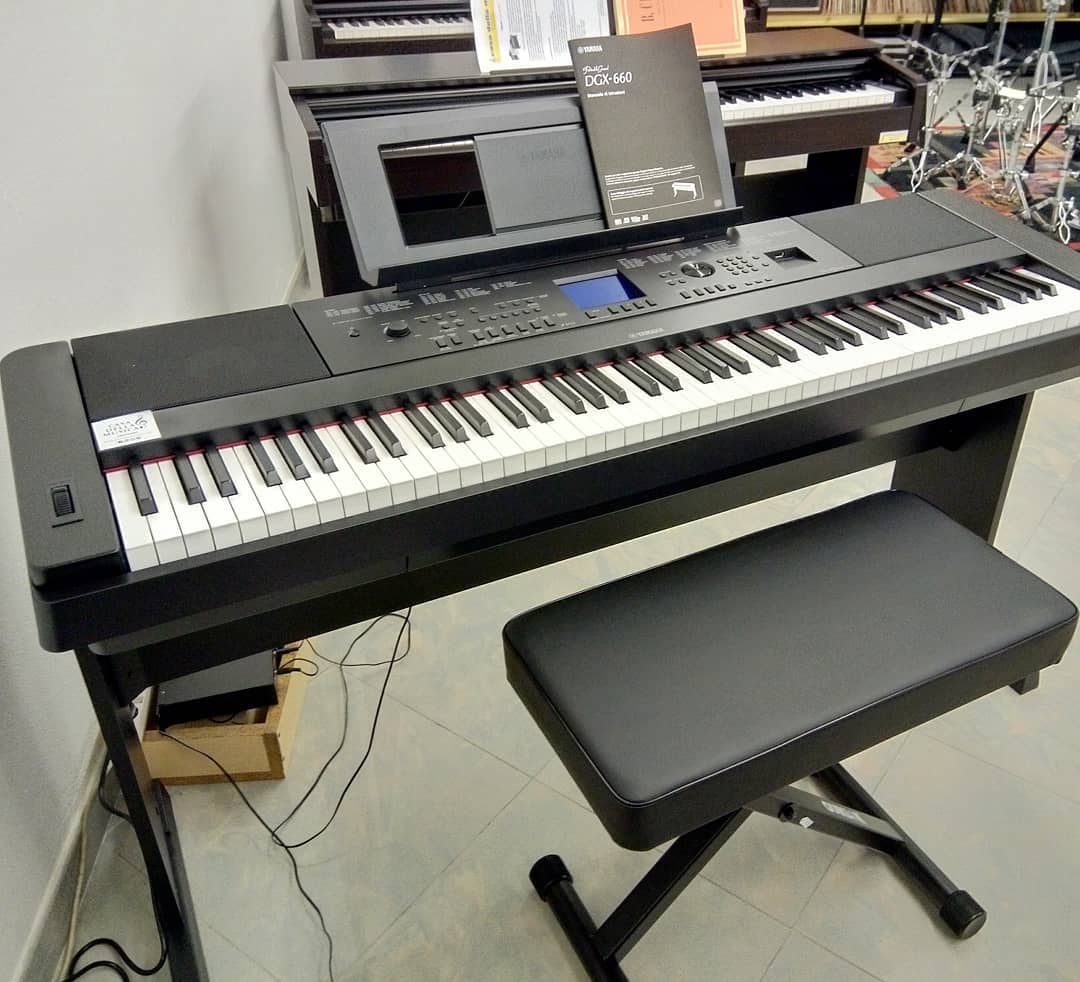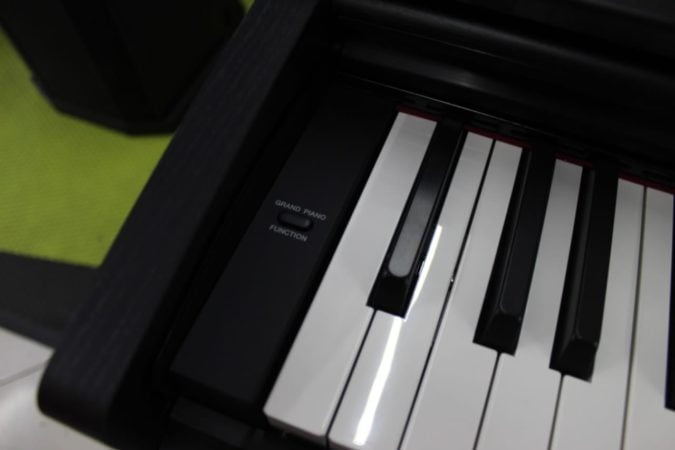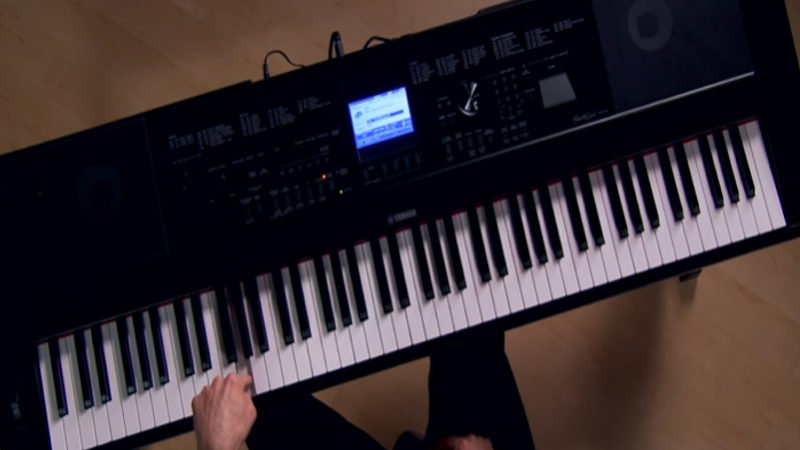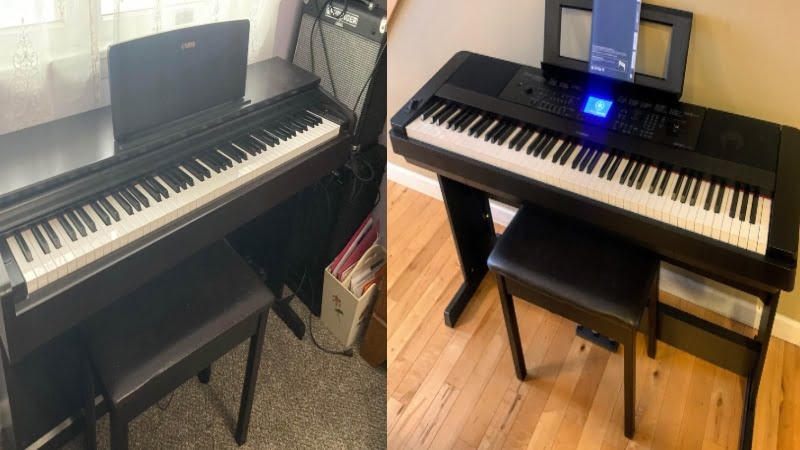If you’re looking for a digital piano, check out this Yamaha YDP-103 vs DGX-660 review to find out which model is better for you.
The Yamaha YDP-103 and the DGX-660 are two very different pianos. The YDP-103 is considered an entry-level and budget-friendly model in the Arius series, while the DGX-660 is known as a middle-of-the-pack model in the Portable Grand series.
I really enjoyed comparing the Yamaha YDP-103 vs DGX-660 because of all their differences and features. But at the end of it, I found that the DGX-660 offered more versatility as a premium and portable digital piano.
With that said, it also costs more.
So, if you’re in need of something more budget friendly, the YDP-103 might actually suit you better.
But if you’re still on the fence, you can check out all the details and features of each model as in this quick comparison.
Yamaha YDP-103 vs DGX-660: Comparison Chart




Last update on 2025-12-23 / Affiliate links / Images from Amazon Product Advertising API
Yamaha YDP-103 vs DGX-660: The Features
Whenever I compare digital pianos, I decide to put all the features up against each other in a head-to-head comparison. That way, I can come up with a final score to declare the fair winner. And after checking out all the features of these pianos, the Yamaha DGX-660 eventually won out with a score of 2-1.
It was a pretty close battle all throughout, but even if you pay more for the DGX-660, you get more features and versatility, which is an important factor for many pianists.
Tone
The winner: DGX-660
There was no doubt in my mind that the DGX-660 had better voices. Since it’s a more premium piano, it uses a better tone engine and has a wider sound library. While the YDP-103 has a decent library for beginners and novices, performing pianists might find the tones to be limiting.
+Tone Generation
To start, the DGX-660 uses one of Yamaha’s most sophisticated tone engineers: the Pure CF Sound Engine. While it may sound complicated, it’s actually just high-quality samples that you trigger whenever you press a key.
The difference, however, is that the samples are recorded with the best equipment in the industry and the pianos used for the recordings are actually Yamaha CF Concert Grand Pianos, some of the best in the game.
So, you can expect the DGX-660 to have incredibly high quality and realistic tones. On the flip side, the YDP-103 uses the AWM Sampling Method.
This produces some of the most realistic tones in its price range. But when compared to the Pure CF Sound Engine, it doesn’t hold up.

+Sound Library
Another area where the Yamaha DGX-660 clearly won out is in the sound library. WIth the DGX-660, you get hundreds of different voices. Since it’s a portable piano, this versatility is incredibly important. That way, you can take on different musical roles and also play a lot of genres.
On the YDP-103, you have a more basic sound library. This isn’t necessarily a bad thing, since it’s important for beginners to focus on the basics before moving on to more advanced concepts. So, the fact that the YDP-103 only has high-quality piano, strings, electric piano, and bass tones makes it a top option for any beginner pianist.
Feel & Playability
The winner: Tie
There was no separating the two of these pianos when it came to feel, because they use the exact same mechanisms to emulate an acoustic piano. However, in terms of key texture, the Yamaha YDP-103 actually had a slight advantage, which came as a surprise, considering the price of these two pianos.
+Hammer Action
The Yamaha YDP-103 and the DGX-660 use the same hammer action system. This is the Graded Hammer Standard or GHS. This is the system you can find on most pianos in the sub $1,000 price range of Yamaha. So, it shouldn’t come as a surprise that you can find it on the YDP-103.
With that said, I was pretty disappointed that the DGX-660 didn’t use the GH3 system, which produces a more realistic spring back compared to GHS. This might be because it’s a portable piano, so you have to sacrifice some realism so that you can bring the piano around with you and use it for multiple genres.
But in the end, since the DGX-660 costs more than $1,000, it would have been nice for it to feature a better hammer action system. With that said, this is a minor complaint and won’t make that much of a difference in the long run.
+Key Texture

In terms of key texture, the Yamaha YDP-103 actually takes the cake. This is because like every piano in the Arius Series, the YDP-103 utilizes textured plastic keys. Granted, this won’t feel exactly like wooden keys, but they will feel more realistic than most other digital pianos on the market.
The Yamaha DGX-660 has basic plastic keys. These have a pretty slippery feel to them, but they aren’t too bad. With that said, considering the cost of the DGX-660, it would have been nice if it came with a more realistic keyboard.
This is a huge testament to how the YDP-103 offers some of the best value for the money on the market today. While it may not have as many premium features and qualities as the DGX-660 and other expensive models, it can definitely hold its own, making it a very popular option.
Piano Features
The winner: Yamaha DGX-660
Portable digital pianos are designed to be workhorses. So, it should come as no surprise that the DGX-660 came with more features than the YDP-103. For a piano that’s designed to stay in one place, the YDP-103 is pretty versatile, but the DGX-660 is designed to handle a variety of genres and playing styles, which is why it was the winner at the end of the day.
+Effects
The Yamaha YDP-103 only comes with reverb effects. This might be all you’ll really need as a beginner pianist or even a novice pianist, as it does give you a fair amount of control over your tone. With that said, even with four different presets, the YDP-103s set of effects is pretty limiting.
With the DGX-660, you get master EQ, chorus, DSP, and IAC on top of all the reverb effects. This allows you to provide a wide range of different textures and tweaks to your tone, making it something that truly reflects your playing style.
This is why the DGX-660 is best recommended for professional musicians with a lot of experience in the field.
+Polyphony
Since the DGX-660 uses multi-layered samples, it needs high polyphony. So, the 192-note maximum polyphony on the Yamaha DGX-660 is more than enough to handle the samples. When playing the DGX-660 you won’t run into any trouble, even when playing dense and wide chords on the piano.

I didn’t run into any polyphony problems with the YDP-103. While the sound wasn’t as high-quality as the DGX-660, the cheaper YDP-103 could handle most chords and pieces, even if it only has 64-note maximum polyphony.
Nowadays, polyphony isn’t as important as it used to be. This is because computing technology has gone so far that most companies can easily give the piano enough power to handle just about any type of chord or note combination.
Yamaha YDP-103 vs DGX-660: The Similarities
These two pianos come from the same brand. But they are completely different pianos from two separate Yamaha Product Lines. With that said, that doesn’t mean they don’t share any similarities.
For example, both pianos come with layering and duo mode. This allows you to either blend two voices together or divides the piano into two mini keyboards for piano lessons. These are really cool features to have on a digital piano and increase their functionality.
Additionally, they also use the same hammer action system. As mentioned earlier, this was a slight letdown since I was looking forward to GH3 hammer action on the DGX-660, but GHS works just fine.
If you need to invest in a piano for a wide variety of purposes, the DGX-660 is your best pick. But if you’re on a budget and in need of an affordable and functional digital piano, then we highly recommend the YDP-103.
Quick Rundown of the Yamaha YDP-103
- Your purchase includes One Yamaha Arius Series, YDP103 model | Bench, Owner’s manual & Quick Operation Guide
- Piano dimensions – 53-7/16” W x 32-1/16” H x 16-5/8” | Weight – 82 lbs. | Number of pedals – 3 | Max polyphony – 64 | Number of voices – 10 | Headphones – (2) Standard Stereo phone jack | No recording nor playback capabilities
- GHS weighted action is heavier in the low keys and lighter in the high keys, just like an acoustic piano
- The special matte black key tops are designed to absorb moisture and remain tactile after extended use without becoming slippery
- The controller app for iOS devices adds a rich graphical user interface, allowing for quick and easy navigation and configuration
Last update on 2025-12-23 / Affiliate links / Images from Amazon Product Advertising API
Quick Rundown of the Yamaha DGX-660
- The Pure CF Sound Engine faithfully reproduces the tone of a meticulously sampled and highly acclaimed Yamaha concert grand piano
- GHS weighted action is heavier in the low register and lighter in the high, just like an acoustic piano
- Score display puts music notation of MIDI songs on the screen, helping you play your favorites by following the bouncing ball
- The Piano room lets you choose from a variety of pianos and acoustic settings to create your own personal piano environment
- The 6 track recorder allows you to capture your performances and song ideas, then add additional layers to spice up your pieces
Last update on 2025-12-23 / Affiliate links / Images from Amazon Product Advertising API
Product Videos
Related Articles to Yamaha Ydp 103
Related Articles to Yamaha Dgx 660
- Yamaha YDP-164 vs DGX-660: Why You Should Go for the DGX-660
- Yamaha DGX-660 vs Roland FP-90: Why the Roland FP-90 Is the Better Pick
- Yamaha DGX-530 vs 660: Why the DGX-660 Is the Better Pick
- Yamaha DGX-505 vs 660: Why the DGX-660 Is the Better Pick
- Yamaha DGX-660 vs DGX-640: A DGX Comparison
- Yamaha DGX-660 vs DGX-630: A DGX Comparison
- Yamaha DGX-620 vs 660: Finding the Best DGX Model
- Yamaha DGX-660 vs YDP-163: Which Is the Better Piano?
- Yamaha DGX-660 vs Roland Juno DS-88: Which Is the Better Piano?
- Yamaha DGX-660 vs Casio PX-360: Which Is the Better Piano?
- Yamaha DGX-660 vs YDP-144: Which Is the Better Yamaha Piano?
- Yamaha DGX-660 vs Korg Havian 30: Which Is the Better Digital Piano?
- Yamaha DGX-660 vs Casio CGP-700: Which Is the Better Pick?
- Yamaha DGX-660 vs YPG-535: Finding the Best Yamaha Digital Piano
- Yamaha DGX-660 vs P515: Is the P515 Worth the Extra Cost?
- Yamaha DGX-660 vs P-115: Which Yamaha Model Is Better?
- Yamaha DGX-660 vs Casio PX-560: Which Piano Offers More Value For The Money
- Yamaha DGX-660 vs 650: A DGX Comparison
- Korg XE-20 vs Yamaha DGX-660: Finding the Best Digital Piano
- Yamaha P45 Vs DGX-660: A Head-to-Head Comparison
- Yamaha DGX 670 Vs 660: The Distinct Difference In Details You Need To Know About
- Casio PX-770 Vs Yamaha DGX-660: Should You Get A Portable Or Console Digital Piano?
- Yamaha P71 vs DGX-660: Can the Amazon Exclusive Beat Out the Premium Model?
- Yamaha P125 vs DGX 660 Comparison: Can the P125 Hold Its Own Against the DGX 660?
References:
- Yamaha YDP-103: https://www.pianodreamers.com/yamaha-ydp103-review/
- Yamaha DGX-660: https://www.pianodreamers.com/yamaha-dgx660-review/
Lulacruza is an electronic folk duo operating at the junction of the hypermodern and the ancient. Our music weaves together hypnotic female singing, South American folk instruments and electronic processing, while channeling pulsating waves from the source of creation.
Lalucruza is also a community where you can connect with other music lovers to collaborate, exchange ideas and share knowledge. A platform for who wants to learns the basics of playing piano, guitar, drum masters’ technique, etc.. is the premise of our website.
